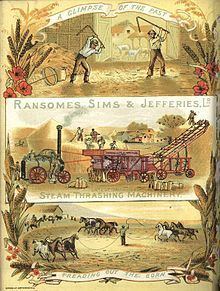Fate Taken over Founded 1789 Ceased operations 1998 | Defunct 1998 Successor Textron Parent organization Ransomes Ltd | |
 | ||
Former type (from 1911) public listed company Products Ploughs, Traction engines, Threshing machines, Combine harvesters, Lawn mowers, Trolleybuses, Forklifts etc Website www.jacobsen.com/europe | ||
Ransomes sims jefferies steam tractor 1912
Ransomes, Sims and Jeffries Limited was a major British agricultural machinery maker also producing a wide range of general engineering products in Ipswich, Suffolk including traction engines, trolleybuses, ploughs, lawn mowers, combine harvesters and other tilling equipment. Ransomes also manufactured Direct Current electric motors in a wide range of sizes, and electric forklift trucks and tractors. They manufactured aeroplanes during the First World War. Their base, specially set up in 1845, was named Orwell Works.
Contents
- Ransomes sims jefferies steam tractor 1912
- Ransomes sims jefferies no 38008 enterprise on the road
- History
- Mowers
- Styles
- Products
- Publications
- References
Ransomes' railway equipment business was hived off in 1869 with a different ownership as Ransomes & Rapier and based nearby at Waterside Ironworks.
Ransomes sims jefferies no 38008 enterprise on the road
History
The enterprise was started by Robert Ransome (1753-1830), a brass and iron-founder in Norwich before moving to Ipswich in 1789 where he started casting ploughshares in a disused malting at St Margaret's Ditches in Ipswich, with capital of £200 and one employee. As a result of a mishap in his foundry, a broken mould caused molten metal to come into contact with cold metal, making the metal surface extremely hard – chilled casting – which he advertised as 'self sharpening' ploughs, and received patents for his discovery.
In 1809 Robert Ransome made his eldest son, James Ransome (1782-1849), his partner and they called themselves Ransome & Son. In 1826 James's son known as Allen but technically James Allen Ransome (1806-1875) went to live at Yoxford, Suffolk, where he established a branch of the business. In 1839 Allen Ransome moved from Yoxford to Ipswich and under his direction the firm of J, R & A Ransome (James, Robert and Allen Ransome) was to assume huge proportions. After about 1841 the manufacture of ploughs and other agricultural machinery was supplemented by production of portable, traction and other steam engines and thrashing machines.
In the middle decades of the 19th century the company produced heavy iron work for astronomical telescopes, mountings, and observatories.
These included
In 1851 export trade was initiated which by the early 20th century was more important than the home market and included distributing agencies throughout the world with a branch establishment in Odessa.
In 1869 four engineers, Allen, who remained the senior partner in the parent firm, his elder son R.J. Ransome, R.C. Rapier and A.A. Bennett, took the firm's railway department aside from the parent business and established Ransomes & Rapier at Riverside Works, Ipswich.
An independent factory was set up for the manufacture of lawn mowers of every class Ransomes produced the 'Automaton' hand-powered lawn mower in 1867. In 1902 Ransomes produced the first commercially available powered lawn mower, driven by an internal combustion gasoline engine.
In the First World War, they manufactured aeroplanes: 350 Royal Aircraft Factory F.E.2 fighters.
In the 1950s Ransomes started producing forklifts, Class 1 Lift Code 5 (Electric Sit Down Counterbalance). With the start of production of the A Series, Ransomes forklifts were sold by the Hyster dealership network under Hyster serial number codes (A21R, A22R, A23R - the R standing for Ransomes Ipswich plant). The codes still show in the Hyster serial number system.
Ransomes also started producing Class 2 Lift Code 3 (Electric Stand On Reach Straddle) machines. Later the company expanded to producing Class 6 Lift Code 1 (Electric Tow Tractors).
When Hyster Corporation bought Lewis Sheppard, the largest market for Ransomes forklifts disappeared. In the early 1980s Ransomes sold their forklift line to Hawkins Mechanical Handling, which produced machines under the Hamech Ransomes brand name. Hawkins Mechanical Handling was later purchased by Crown, and the Hamech name retired, until 2004, when Crown brought it back for use in an Internal Combustion Engined forklift line.
In 1989 the whole of the agricultural implement business was sold to Electrolux and merged with their subsidiary Överum.
This left Ransomes solely as a manufacturer of lawn mowers, with the Ransomes, Westwood and Mountfield mower brands. The company accepted a take-over offer from Textron Inc., USA, and their independent existence ended early in 1998. Westwood and Mountfield were later sold in a management buyout.
The history of the company and preceding businesses is the subject of an exhibition at the Museum of East Anglian Life in Stowmarket, Suffolk and they are also represented in Ipswich Transport Museum.
Mowers
Ransomes to this day still produce a variety of grass cutting equipment. From professional high quality turf machines to more industrial gang mowers for use on wider areas such as public parks etc. Yet they do still make a range of pedestrian mowers for use on manicured lawns and bowling greens for example.
Styles
The business begun by Robert Ransome was later owned as partners by various individuals. The different names or styles by which the one enterprise was known before it was bought in 1884 by the limited liability joint-stock company Ransomes, Sims & Jeffries Limited were:
Products
Ransomes & May 1848 catalogue
